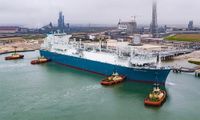The United States has firmly maintained its position as the world’s leading exporter of liquefied natural gas (LNG) in 2024, with exports averaging 11.9 billion cubic feet per day (Bcf/d), according to the U.S. Energy Information Administration (EIA). This figure is consistent with the previous year, demonstrating the country’s stronghold in the global LNG market.
In comparison, Australia and Qatar, the second and third largest exporters, have seen their exports stabilize over the past five years, ranging from 10.2 Bcf/d to 10.7 Bcf/d annually. Meanwhile, Russia and Malaysia have continued to rank as the fourth and fifth largest LNG exporters, with Russia averaging 4.4 Bcf/d and Malaysia 3.7 Bcf/d in 2024.
Despite the U.S. maintaining its export levels, the year was not without challenges. Unplanned outages at existing LNG export facilities and a decrease in natural gas consumption in Europe contributed to a stagnation in export growth compared to 2023. The U.S. did, however, see the launch of the Plaquemines LNG Phase 1 in December 2024, marking the addition of the eighth U.S. LNG export facility.
Utilization rates across the seven operational U.S. LNG terminals averaged 104% of nominal capacity and 86% of peak capacity, indicating robust operational efficiency. Europe remained the primary destination for U.S. LNG, accounting for 53% of total exports, while the share of exports to Asia increased from 26% to 33% in 2024.
Interestingly, U.S. LNG exports to other regions, including the Middle East, North Africa, and Latin America, rose significantly, comprising 14% of total exports in 2024 compared to just 8% the previous year. However, exports to Europe saw a notable decline of 19% (1.5 Bcf/d) primarily due to reduced consumption and high storage inventories following a mild winter.
The dynamics of U.S. LNG exports to Europe have shifted, with imports decreasing significantly for many EU countries. In particular, U.S. LNG exports to other EU nations and the UK dropped by 24% in 2024. The Netherlands, France, and the UK continued to lead in U.S. LNG imports, accounting for 46% of the regional total.
In terms of Asian markets, Japan, South Korea, India, and China were the largest importers, collectively making up 76% of U.S. LNG shipments to Asia. Notably, U.S. LNG imports into China plummeted from 7.2 Bcf in December 2024 to zero in January 2025, indicating a significant downturn in trade relations.
Meanwhile, the European Union has enacted a ban on the re-exportation of Russian LNG, effective March 28, 2025. This ban, which targets Russian LNG cargoes passing through EU ports, is aimed at further limiting Moscow's energy revenues. However, analysts note that this ban affects only a small fraction of Russia’s total LNG exports, as trans-shipments through EU ports accounted for less than 10% of Russia's total LNG export volume in 2024.
Despite this ban, EU imports of Russian natural gas saw an 18% increase in 2024, with data from February 2025 suggesting continued growth. The EU's reliance on Russian gas remains a contentious issue, as political commitments to reduce dependency have not yet translated into significant reductions in imports.
Additionally, logistical challenges are presented by the EU's ban. Icebreaker vessels from Novatek’s Yamal LNG, for example, cannot access Arctic terminals during the winter months, necessitating offloading at EU terminals for re-export. In 2024, approximately 47 such transfers occurred, primarily under long-term contracts with major energy firms.
As the global LNG landscape continues to evolve, the U.S. remains a critical player, navigating the complexities of international energy trade while facing emerging challenges from both logistical and geopolitical fronts. The interplay between U.S. exports, European energy policies, and Asian market dynamics will undoubtedly shape the future of the global LNG market.
In summary, while the U.S. has solidified its position as the top LNG exporter, the fluctuating dynamics of global demand, regional policies, and geopolitical tensions will play a pivotal role in determining the trajectory of LNG exports in the coming years.






